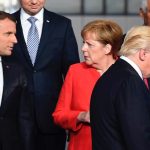by Saeid Golkar
Mohammad Aqamiri might be the first-ever Shia cleric from Iran who martyred himself in Syria after the Syrian uprising. While studying and teaching at Qom Seminary in 2013, Aqamiri enlisted in the Islamic Revolutionary Guard Corps and died defending the holy shrine in Syria.
He is not alone. Some 400 Iranians have been killed so far in Syria fighting for Bashar al-Assad and against the Islamic State (ISIS or IS). Iran has identified 18 of these as Shia clergymen. These clerics have a dual identity, claiming the status of religious leaders yet at the same time participating in and even leading a violent, religious struggle. Their militarization is a new development that threatens to further radicalize Shia Islam.
Shia Islam was once a religion of quietism. Historically, Shia clergy disagreed with coupling politics and religion. However, in 1970 Shia Islam started to become more involved in politics under the influence of Ayatollah Ruhollah Khomeini, who overthrew the Pahlavi dynasty. After the Iranian revolution and the establishment of the Islamic Republic in 1979, clergy also became involved in the state’s bureaucratic affairs and some began to join military and security apparatuses.
In 1988, Iran’s supreme leader died, and Ali Khamenei became the new supreme leader. He was middle-ranked clergy and did not enjoy too much legitimacy among the higher-ranking clerical establishment. To compensate for this lack of legitimacy, he tried to control the seminary school system (howzeh). Shia seminary schools were traditionally independent from the state, but Khamenei tried to bureaucratize the schools and bring them under state control. He expanded the presence of clergy in the military and security establishment, mainly drawing from the younger generation of clergy. This younger generation in the seminaries is the social base of Ayatollah Khamenei, who controls the clergy and the military at the same time.
After reformists took power in 1997, Ayatollah Khamenei relied more on this group to block reform and consolidate his power and authority when challenged. Since hardliner Mahmoud Ahmadinejad took power in 2005, the power of this clergy militia has expanded, particularly among the political elite. These clergy militants are notable for their loyalty to Iran’s Supreme Leader, Ayatollah Khamenei, and their numbers have skyrocketed since 1988. About 4,000 serve with Iran’s armed forces; no fewer than 2,000 work for the Islamic Revolutionary Guard Corps. These officers have studied at Iranian seminaries. They are known to wear clerical clothes on duty but work in security and the military. They work mainly for the armed forces’ ideological political bureaus and counter-intelligence branches to indoctrinate and oversee military personnel. Their position of influence and power can, in essence, be compared to a Communist political commissar.
Not only are these new militant clergy joining the Islamic Revolutionary Guard Corps, another 140,000 of the 400,000 clergy and seminary students in Iran are members of the Basij, a branch of the state militia. Although a majority is lower ranked, some have advanced military and security training. The clerical Basij is mainly responsible for controlling seminary schools, but many have also become involved in military combat units set up to help the Islamic Republic suppress social or political riots and defend the regime in a possible civil war.
Since the beginning of the uprising against Assad, some of these new clerical militia have been deployed to Syria and Iraq and have joined in fighting the Salafi groups, or Sunni radicals. The phenomenon has even spread outside Iran, ensnaring some international students studying at Iranian seminaries to become clergy, particularly in the Qom and Mashad seminaries. These seminary students comprise the core of Shia militia groups in the Middle East. The examples are numerous:
- Several members of the Fatemiyoun Brigade, an Afghan Shia militia allied with Assad, are Afghan seminary graduates of Al-Mustafa International University in Qom. As a clergy militia, this group has a connection with the masses and can recruit Afghan immigrants in Iran to be deployed to Syria to fight with the Assad regime. These include Ali Reza Tavassoli, also known as Abu Hamed, the late former commander of the Fatemiyoun Brigade, and his deputy, the late Reza Bakhshi, also known as Faateh. Mohammad Rezai, another Afghan member of Fatemiyoun, later killed in Syria, studied at a branch of Al-Mustafa University in Mashhad.
- The Zeynabiyoun Brigade has recruited Pakistani Shia seminary students who are studying in Iran. Some have been killed inSyria and buried in Qom. At least three of seven Pakistanis killed in Syria and buried in Qom in April 2015 were students from the Al-Mustafa International University. Most of these students were native to Pakistan’s Parachinar region, a Shia area in Pakistan known for the close ties between its seminaries and Iranian seminaries and an increasing source of both male and female seminary students in Iran.
- In Iraq, the Heydarian Brigade, made up of Iraqi Shia militias, includes several militant clergy members. Such clergy also belongs to other militia groups, such as the Popular Mobilization Forces, formed under Hash’d al-Sha’bi, a militia umbrella organization. Muqtada al-Sadr, leader of Saraya al-Salam and the former head of the Mahdi Army, who currently lives in Qom, is a former student of a Qom seminary school. And Qais al-Khazali, an Iraqi who is predominantly known for his departure from the Mahdi Army to form Asaib Ahl al-Haq, studied in Qom as well.
In brief, while traditional Shia clergy have stayed out of government, the militant Shia clergy have become a tool for the Islamic Republic to implement its domestic and regional policies. Due to their military and religious authority, these clerical militia are becoming more powerful and influential in seminaries than their traditional and non-political counterparts, who are more supportive of the traditional separation of Islam and politics. By undermining traditional clergy, this new wave of militant Shia clergy has the power to radicalize future followers of Shia Islam, snowballing the growth of militarized Shia clerics and perhaps even triggering a counter-militarization of Sunni clerics in response.
Photo: Iranian seminar students protest execution of Shia cleric Nimr al-Nimr.
Saeid Golkar is a lecturer for the Middle East and North African Studies Program at Northwestern University, a visiting senior fellow for Iran policy at the Chicago Council on Global Affairs, and a consulting senior fellow at the International Institute for Strategic Studies.





